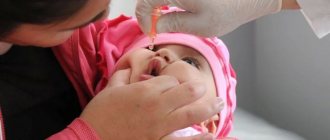The polio virus causes severe consequences for human health, including disability and death. The only effective way to protect against it is vaccination. According to the Russian National Calendar, children are vaccinated against polio six times - three times in the first year of life, at 18 and 20 months, and at 14 years.
Adults who have not previously been immunized can be vaccinated at any time. Before going to a medical facility, you should carefully study whether the polio vaccine has contraindications for use in children and adults.
Contraindications to polio vaccination in children and adults
Before we talk about contraindications, we will differentiate vaccines by type. There are two of them:
- OPV or oral live vaccine . It is this that poses a danger to the people around the person being vaccinated and to himself, but only if they have not been immunized previously. The threat is that vaccine-associated polio (VAP) may develop. The drug is dripped into the mouth;
- inactivated polio vaccine or IPV . The development of VAP is excluded both in the person being vaccinated and in those around him, regardless of whether they have been vaccinated previously. As a rule, children are administered simultaneously with antigens against whooping cough, diphtheria and tetanus. Foreign polyvaccines (Infanrix, Pentaxim and others) contain a component against polio, among other things.
Knowing about possible contraindications, you can easily avoid serious health consequences.
Absolute contraindications
Immunization should not be carried out if the following conditions are present:
- allergy to antibiotics: neomycin, streptomycin and polymyxin B, which are part of the vaccine;
- neurological disorders that developed following previous administration of a polio drug;
- state of immunodeficiency in the vaccinated person;
- pregnancy;
- hypersensitivity reactions to previous polio vaccination. Such phenomena include: shock, urticaria, bronchospasm, Quincke's edema;
- serious health problems in persons living with the vaccinated person. This applies only to the OPV vaccine. After immunization with a “live” vaccine, a child or adult poses a danger to people with severe health problems, first of all, we are talking about patients with HIV, AIDS and oncology, as well as pregnant women;
- the presence of malignant neoplasms.
The first three vaccinations for children are given with IPV drugs, and the subsequent ones with OPV vaccines. This scheme not only allows you to form 100% immunity to infection, but also completely eliminates the risk of developing VAP.
Temporary restrictions
Vaccination should be postponed in the following cases:
- exacerbation of any chronic pathologies. In such a situation, it is important to wait for a period of stable remission;
- any infectious processes in the body: both accompanied by an increase in body temperature and those passing without severe hyperthermia. Typically, doctors recommend waiting 2-4 weeks after recovery and then getting vaccinated;
- the period of treatment with immunosuppressive drugs is also a temporary contraindication to vaccination. You can get vaccinated, but not earlier than six months after completing the course of therapy.
By taking urine and blood tests the day before the vaccination date, parents can be sure that the child is absolutely healthy, and therefore has no hidden contraindications to vaccination.
When can the vaccine be given?
There are 2 types of vaccines that protect against polio:
- Inactivated. It contains killed strains of the virus that do not multiply when introduced into the body, and therefore cannot cause infection. The immune response is caused by capsid proteins. The introduction is carried out twice.
- Attenuated. Contains a weakened viral culture that stimulates the production of macrophages and lymphocytes. Drops are given 3 times, with an interval of 1.5 months. Revaccination is repeated for the last time when the patient turns 14 years old.
Vaccination rules do not depend on the type of drug used to increase the body's defenses. The child must be healthy. Before entering the vaccination office, you must visit your local pediatrician or therapist.
If the patient has recovered from an infectious disease, it is necessary to maintain a period of at least 2 weeks.
If residual cough or catarrhal symptoms persist, a referral is given for general blood and urine tests.
Whether it is possible to get vaccinated against polio with a runny nose depends on the reasons that caused it.
Physiological rhinitis is not a contraindication. Neurovegetative nasal congestion occurs during extrauterine adaptation to the environment. The nasal mucosa of a baby in the first months of life is not sufficiently formed and reacts to external stimuli by increasing secretion. The condition is not a disease and does not require treatment.
It is allowed to vaccinate a child if there is mucous discharge that appears as a reaction to dust, a strong odor, or stress.
At an early age, a similar reaction may appear due to fear or increased excitement. Indicators of urine and blood tests for these conditions are normal and vaccination is permitted. What do you think are the most important factors when choosing a medical facility?
Is it possible to get the polio vaccine if you have a runny nose?
There are different types of runny nose, so if a child or adult is scheduled for routine immunization and has snot, it is necessary to find out exactly its nature.
For example, the famous pediatrician E.O. Komarovsky does not recommend refusing vaccinations for rhinitis if it is caused by allergies or simply changing weather conditions outside. If your nose is stuffy due to a cold, this is a clear reason to postpone immunization.
Since parents cannot always accurately recognize the nature of a runny nose or other conditions, there is a doctor’s examination before vaccination. A competent specialist will tell you whether the child’s condition is cause for concern and whether it is worth refusing vaccination.
Types of vaccines
Before directly vaccinating their child, the parent must choose which polio vaccine will be given. Currently, there are two of them - injections of an inactivated vaccine containing a killed virus and drops of an attenuated vaccine (OPV), which contains a live but weakened pathogen.
Both vaccinations, according to research, are highly effective in preventing the disease, but there are cases when they can also cause unwanted reactions from the body. Only strict adherence to vaccination rules allows this to be avoided.
Is it possible to get vaccinated during pregnancy and lactation?
Pregnancy is an absolute contraindication to the use of any polio vaccine.
In addition, the ban on vaccination applies in several other cases:
- a woman is just planning a pregnancy. This category is recommended to undergo immunization and only after a few months begin to conceive;
- A child who lives in the same area as a pregnant woman is to be vaccinated with a live vaccine. In this case, it is better to wait until the baby is born;
- woman breastfeeds baby. Vaccination during breastfeeding is also prohibited.
Symptoms of polio
Poliomyelitis can occur with damage to the central nervous system (paralytic form).
However, nowadays polio usually occurs in a non-paralytic form. Non-paralytic form of polio
The non-paralytic form of polio is manifested by symptoms such as fever and headache. Redness of the throat, runny nose, and upset stool may occur. The temperature lasts up to 5 days, all symptoms disappear within a week.
Symptoms of damage to the nervous system
When the central nervous system is affected (paralytic form), the symptoms are more severe: fever, severe headache, vomiting, and possible development of paralysis of various localizations. Paralysis appears suddenly, and in some patients it occurs within a few hours. The paralytic period of the disease lasts up to 2 weeks, after which it is replaced by a recovery period, which can last up to 3 years. In most cases, complete recovery occurs, but approximately every fourth case of paralysis ends in disability. Death is also possible due to paralysis of the respiratory muscles or pharyngeal muscles.
Is there an alternative to vaccination?
Only timely immunization can protect a person from polio. To date, there is no other proven way or method that will help avoid infection when meeting a sick person.
Strong immunity, hardening procedures, taking vitamins, seasonal use of antiviral agents and immunomodulators will not protect either a child or an adult.
Here are a few more reasons in favor of vaccination:
- The polio virus is highly contagious, that is, it is very easy to become infected with it, and not only through direct contact;
- despite the fact that since 2002 Russia has been declared a polio-free territory (this is the fact that all ardent anti-vaccinationists refer to), the risk of infection remains. Thus, outbreaks of the disease were recorded in 2010 in neighboring Tajikistan. In addition, in many countries of the world the situation with polio is not so favorable, and our compatriots travel and work all over the world;
- Currently, no effective method has been invented to treat the disease. Therapy, as a rule, is only symptomatic, that is, it is aimed at relieving the unpleasant manifestations of the infection;
- The polio vaccine causes virtually no reactions. In extremely rare cases, an allergy develops, which can cause Quincke's edema or urticaria;
- Vaccine-associated paralytic poliomyelitis is the most dangerous and frightening complication of immunization. It occurs with a frequency of 1 case per 3 million inhabitants. As a rule, a person immunized with a live vaccine infects a person who has not been vaccinated before. Those vaccinated against polio (even IPV) have a 0% risk.
When not to do it and why
You will have to postpone polio vaccination if you have a cough, which is a symptom of the inflammatory process, and a runny nose, which occurs against the background of a deterioration in your general condition and an increase in temperature. Catarrhal phenomena can be not only signs of ARVI, but also occur in the prodromal period of diseases: rubella, chickenpox, measles, scarlet fever and the like. Vaccination at this time can provoke the development of severe side effects. When using an attenuated vaccine, there is a risk of getting polio.
But this is not the only contraindication to vaccination in children. You cannot give injections or take drops:
- in immunodeficiency states, or when there are people with reduced immunity in the environment who are at risk of contact with carriers of the infection;
- during exacerbation of chronic diseases;
- if you are intolerant to antibiotics - Polymyxin B, Neomycin or Streptomycin;
- for chemotherapy and radiotherapy - after completing the therapeutic course, you need to wait a period of 6-8 months;
- when the temperature rises, even if it is caused by an unusual environment or overexcitation;
- for diseases of the nervous system, if one of the symptoms is seizures.
The vaccine should not be given if you have a runny nose, which appears as a result of allergies or seasonal hay fever. When reacting to allergens, immunity decreases and when foreign proteins are introduced, there is a high probability of side effects and complications - false croup, bronchial asthma, acute bronchitis. An exemption from revaccination is given if negative neurological manifestations and allergies to the previous administration of the vaccine appear.









